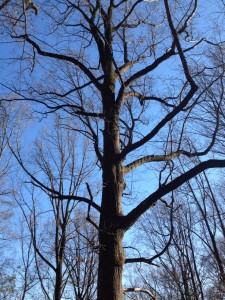By Melissa Nase, Manager of Land Stewardship
 Every day at the Schuylkill Center I am reminded of the passing of time, the history of the land, and the immense power of plants to change our landscape. Amazed at how the trees could grow so tall in just 50 years, I stand in awe of the towering tulip poplars (also called tuliptrees) which rise high above old fields once clear cut for agriculture. As winter approaches and vegetation retreats, ruins and farm walls of old homesteads – signs of literally hundreds of years of human occupancy – reveal themselves as markers of the past.
Every day at the Schuylkill Center I am reminded of the passing of time, the history of the land, and the immense power of plants to change our landscape. Amazed at how the trees could grow so tall in just 50 years, I stand in awe of the towering tulip poplars (also called tuliptrees) which rise high above old fields once clear cut for agriculture. As winter approaches and vegetation retreats, ruins and farm walls of old homesteads – signs of literally hundreds of years of human occupancy – reveal themselves as markers of the past.
 Trees can also be a source of information to us; they are simultaneously signs of resilience and indicators of land use patterns. Some of our oldest, biggest trees are situated just at the edges of former farm fields, where they could stretch and branch in all directions due to unlimited sunlight. In the forest, the same species would be taller and thinner, with branches reaching directly up toward the sun shining through a break in the forest canopy. For many years, these remarkable old trees have drawn interest from visitors, staff, and volunteers at the Schuylkill Center.
Trees can also be a source of information to us; they are simultaneously signs of resilience and indicators of land use patterns. Some of our oldest, biggest trees are situated just at the edges of former farm fields, where they could stretch and branch in all directions due to unlimited sunlight. In the forest, the same species would be taller and thinner, with branches reaching directly up toward the sun shining through a break in the forest canopy. For many years, these remarkable old trees have drawn interest from visitors, staff, and volunteers at the Schuylkill Center.
In the summer of 1974, volunteer Gus Wiencke assembled an extensive report entitled “Biggest Trees at the Schuylkill Valley Nature Center,” detailing land history and size, species, location, and even sketches of growth patterns of the property’s largest trees. The original survey presents 57 trees that measure over 6 ½ feet in circumference, although many far exceed that now. The survey was partially updated in 1986 and again in 2012, when eight more trees were added to the list.
It has been 40 years since Gus compiled this list of biggest trees, yet I’m experiencing his observations in a similar way these days. He concludes, “Year after year, traces of the old farm fields grow dimmer and a forest spreads in the protected haven of the Nature Center. Our biggest trees are the aristocrats in a unique, unviolated area of self-propagated woodland.” These trees exist with little help from us, and in many cases, perhaps, in spite of us. They are beautiful and vital beings in our ever-changing landscape. Join us at the Giants of the Forest walk in January to see some of these big trees, learn about why they remained during the farm years, and find out what they can tell us about the past.
Note: an excerpt from this article appeared in the winter 2014-2015 Quill, the Schuylkill Center members newsletter.
